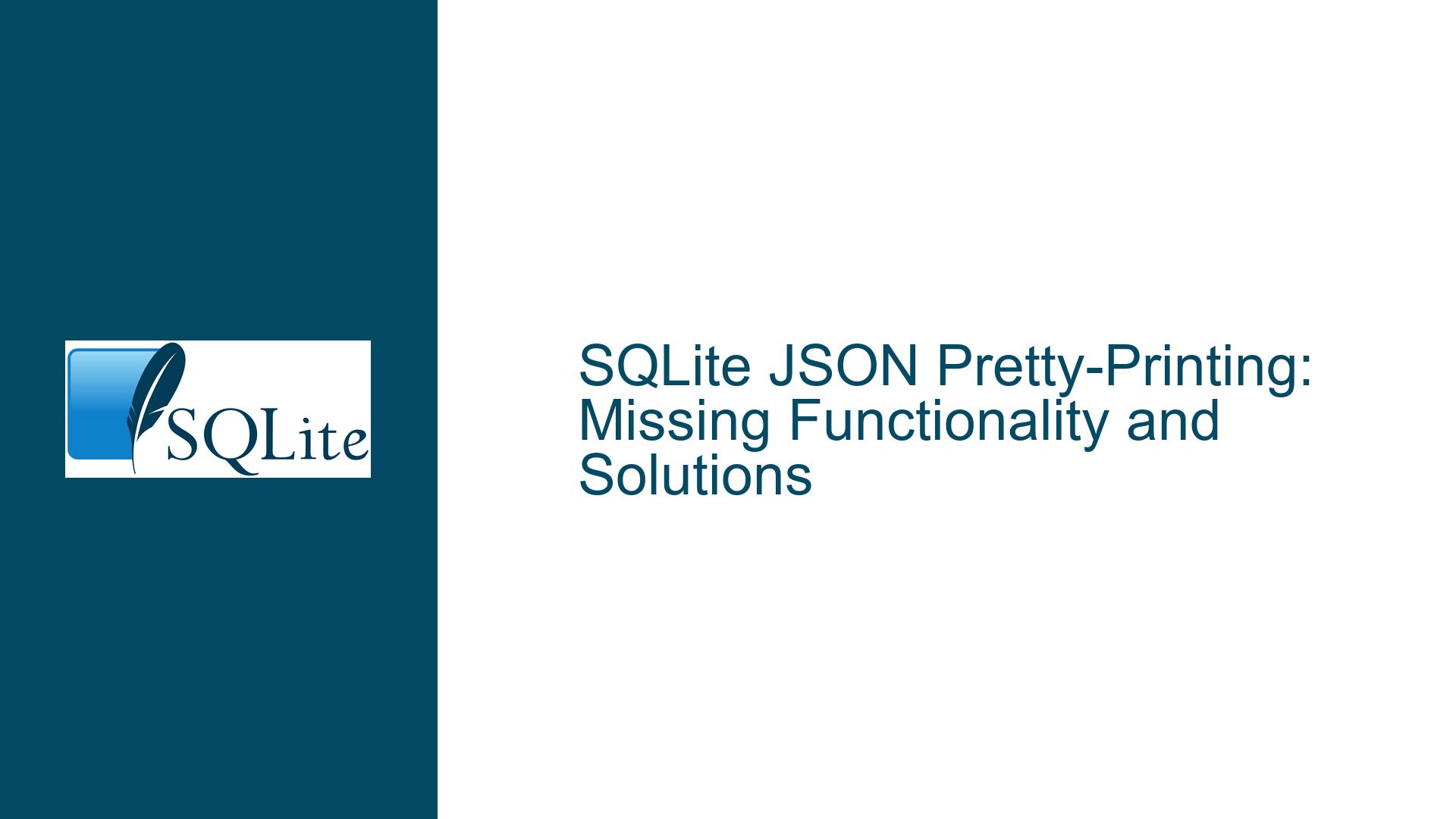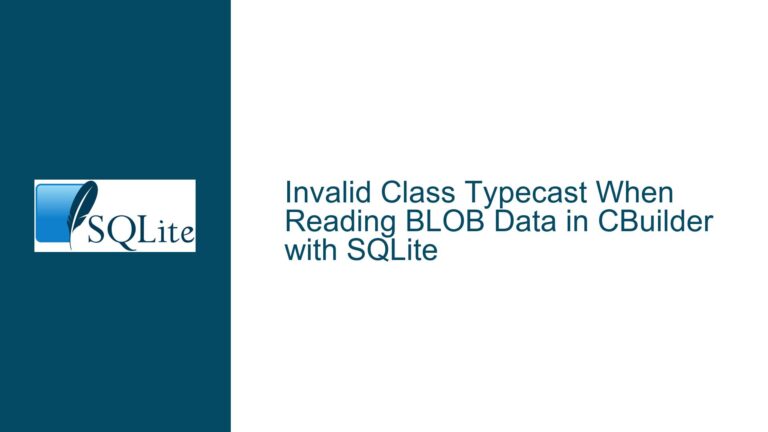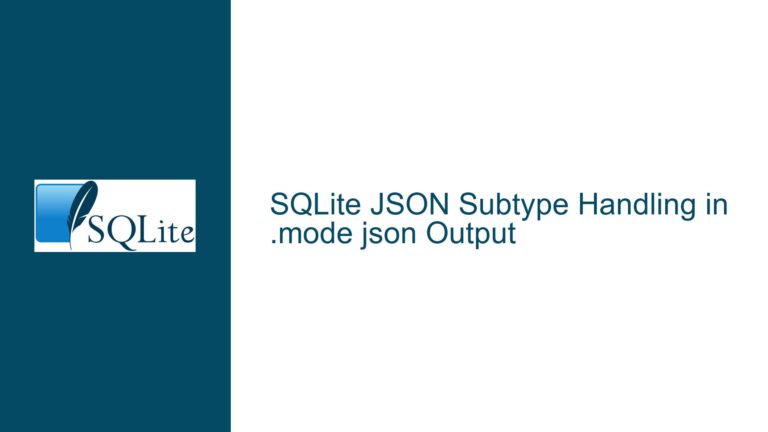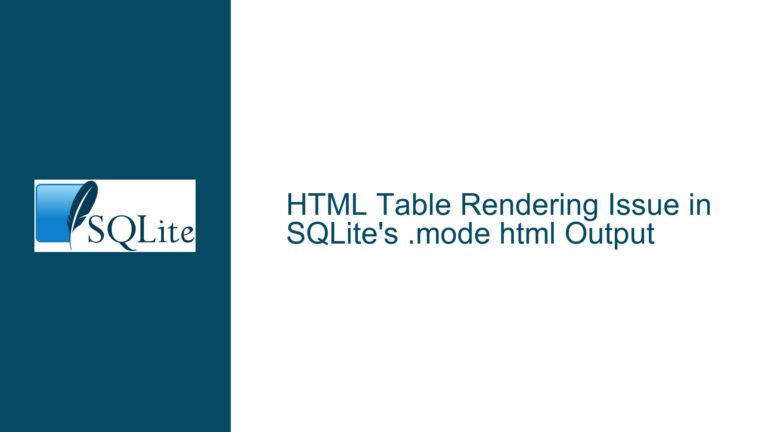SQLite JSON Pretty-Printing: Missing Functionality and Solutions
Core Problem: Absence of Built-In JSON Pretty-Printing in SQLite
Issue Overview: Storing vs. Human-Readable JSON Presentation
SQLite’s JSON1 extension provides robust support for storing, querying, and manipulating JSON data. However, a critical gap exists in its functionality: the inability to convert minified JSON into a human-readable, indented format directly within SQLite. Users who store compact JSON (without whitespace) for efficiency and machine processing face challenges when attempting to inspect or debug this data manually. The JSON1 extension includes functions like json() and json_quote() for minifying JSON (removing unnecessary whitespace), but lacks a counterpart for "pretty-printing" (adding indentation and line breaks). This omission forces users to rely on external tools like jq or custom application-layer logic to format JSON for readability.
The discussion highlights several scenarios where this limitation becomes problematic:
- Interactive CLI Workflows: Users working in the SQLite command-line interface (CLI) or third-party GUIs without JSON-aware formatting features cannot easily inspect nested JSON structures.
- Debugging and Auditing: Developers troubleshooting data inconsistencies or validating JSON schemas need to visualize hierarchical relationships within JSON objects or arrays.
- Symmetry in Functionality: The JSON1 extension already provides minification (
json()), so the absence of a complementary pretty-printing function feels inconsistent.
The core technical challenge lies in SQLite’s design philosophy, which prioritizes minimalism and efficiency. Features deemed "presentational" are often excluded from the core library, as seen in historical decisions around locale-specific formatting or thousand separators. However, JSON’s ubiquity in modern applications has elevated the importance of built-in pretty-printing as a usability requirement rather than a purely cosmetic feature.
Root Causes: Why SQLite Lacks Native JSON Pretty-Printing
Three primary factors explain why SQLite does not natively support JSON pretty-printing:
Philosophical Constraints on Presentation Logic
SQLite’s core library avoids including functions that are strictly presentational. Theprintf()andstrftime()functions exist because they serve dual purposes (e.g., data transformation and formatting), but purely aesthetic features like JSON indentation are considered outside the library’s scope. This design minimizes bloat and ensures SQLite remains lightweight.Complexity of Formatting Preferences
Pretty-printing JSON involves subjective decisions that complicate standardization:- Indentation Style: Spaces vs. tabs, and the number of spaces per indent level (2, 4, etc.).
- Brace Placement: Whether opening braces appear on the same line as their parent key or on a new line.
- Whitespace Around Delimiters: Adding spaces after colons (
"key": valuevs."key":value) or commas.
Implementing one style risks alienating users who prefer alternatives, leading to debates over configurability.
Performance Overheads
Pretty-printing requires traversing the JSON structure to apply indentation dynamically. For large JSON documents (MBs or GBs in size), this could introduce measurable latency. While interactive use cases (e.g., CLI inspection) tolerate minor delays, embedding this functionality in the JSON1 extension might encourage misuse in performance-critical queries.Assumption of External Tooling
SQLite assumes that presentation tasks like JSON formatting are handled by external tools (e.g.,jq, application code). This aligns with the Unix philosophy of "doing one thing well" and delegating specialized tasks to dedicated utilities.
Solutions: Workarounds, Custom Implementations, and Official Fixes
1. Leveraging External Tools for JSON Formatting
Scenario: Users who need occasional pretty-printing within the SQLite CLI can pipe query results to external formatters like jq.
Steps:
- Configure Output Modes: Use SQLite’s CLI commands to prepare the output for piping:
.mode list -- Outputs data without headers or column alignment .headers off -- Suppresses column headers .once '|jq .' -- Pipes the result of the next query to jq - Execute the Query:
SELECT json_column FROM table WHERE id = 123;The JSON string is passed to
jq, which formats it with default indentation.
Limitations:
- Requires
jqor similar tools installed on the system. - Inefficient for batch processing or automated workflows.
- Fails if the JSON is malformed or fragmented across rows.
2. Manual Pretty-Printing Using JSON Table-Valued Functions
Scenario: Users needing a pure SQLite solution can decompose JSON into hierarchical components and reconstruct it with indentation.
Steps:
- Recursive Decomposition with
json_tree():
Thejson_treetable-valued function recursively traverses JSON structures, returning each node’s path, type, and value.WITH RECURSIVE json_nodes AS ( SELECT '0' AS depth, key, type, value, fullkey FROM json_tree('{"a": [1, 2, {"b": 3}]}') UNION ALL SELECT depth + 1, jt.key, jt.type, jt.value, jt.fullkey FROM json_nodes, json_tree(json_nodes.value) AS jt WHERE json_nodes.type IN ('object', 'array') ) SELECT depth, fullkey, type, value FROM json_nodes; - Apply Indentation Based on Depth:
Use thedepthcolumn to generate indentation strings (e.g.,repeat(' ', depth)) and concatenate JSON syntax elements (braces, brackets, commas).
Limitations:
- Complex SQL: Requires intricate recursive CTEs and string manipulation.
- Fragility: Hand-crafted SQL may mishandle edge cases (e.g., escaped characters, nested arrays).
- Performance: Unsuitable for large JSON documents due to repeated parsing.
3. Custom C Extension for JSON Pretty-Printing
Scenario: Developers with access to SQLite’s source code can implement a custom pretty-printing function.
Steps:
Modify
json.cin SQLite’s Source:- Extend the
JsonStringstructure to track indentation level and preferred style (spaces/tabs). - Modify
jsonRenderNode()to insert line breaks and indentation after commas, colons, and braces. - Expose the functionality via a new SQL function (e.g.,
json_pretty()).
- Extend the
Example Implementation Sketch:
static void jsonPrettyRenderNode( JsonNode *pNode, /* Node to render */ JsonString *pOut, /* Output buffer */ int indentLevel, /* Current indentation depth */ int indentSize /* Spaces per indent (0 for tabs) */ ) { switch (pNode->eType) { case JSON_OBJECT: jsonAppendChar(pOut, '{'); for (JsonNode *pChild = pNode->u.pFirstChild; pChild; pChild = pChild->pNext) { if (pChild != pNode->u.pFirstChild) jsonAppendChar(pOut, ','); jsonAppendNL(pOut, indentLevel + 1, indentSize); jsonRenderNode(pChild->pKey, pOut, 0); // Render key jsonAppendChar(pOut, ':'); jsonAppendSpace(pOut); // Optional space after colon jsonPrettyRenderNode(pChild, pOut, indentLevel + 1, indentSize); } jsonAppendNL(pOut, indentLevel, indentSize); jsonAppendChar(pOut, '}'); break; // Handle arrays, strings, primitives similarly... } }
Challenges:
- Maintenance Overhead: Custom forks of SQLite require periodic merging with upstream updates.
- Lack of Portability: Extensions must be recompiled for different platforms.
- Style Rigidity: Hardcoding indentation rules may not satisfy all users.
4. Official Solution: json_pretty() in SQLite Trunk
Scenario: As of March 2024, SQLite’s trunk version includes a native json_pretty() function.
Usage:
SELECT json_pretty(json_column) FROM table;
Features:
- Defaults to 2-space indentation.
- Handles all JSON types (objects, arrays, strings, numbers).
- Preserves JSON validity while adding whitespace.
Implementation Details:
- Indentation Control: The function accepts an optional second argument specifying indent size (0 for no indentation, negative for tabs).
SELECT json_pretty('{"a": [1,2,3]}', 4); -- 4-space indents - Performance: Leverages SQLite’s existing JSON parser, minimizing overhead.
- Edge Cases: Properly escapes embedded quotes and special characters.
Migration Considerations:
- Version Compatibility: Requires SQLite 3.46.0 or newer.
- Backward Compatibility: Queries using
json_pretty()will fail on older SQLite versions unless conditional logic is added.
5. Hybrid Approach: Shell Integration with .output and External Formatters
Scenario: Users constrained to older SQLite versions can combine shell features with external scripts.
Steps:
- Export JSON to a Temporary File:
.output temp.json SELECT json_column FROM table; .output stdout - Process the File with
jq:jq . temp.json
Advantages:
- Works with any SQLite version.
- Allows using advanced
jqfilters (e.g., syntax highlighting).
Drawbacks:
- Involves file I/O, which may be slow or restricted in some environments.
Final Recommendations:
- Upgrade to SQLite 3.46+: Adopt the native
json_pretty()function for simplicity and performance. - Use External Tools for Ad Hoc Analysis: Pipe CLI output to
jqwhen interactively exploring data. - Avoid Manual SQL-Based Formatting: Recursive CTEs are error-prone and inefficient for non-trivial JSON.
- Advocate for Configurable Indentation: Submit feature requests for optional arguments to control indentation style in
json_pretty().
By addressing JSON pretty-printing through official channels, SQLite reinforces its position as a versatile database for modern applications while adhering to its minimalist ethos. Developers now have a robust, built-in solution that balances usability with performance.






